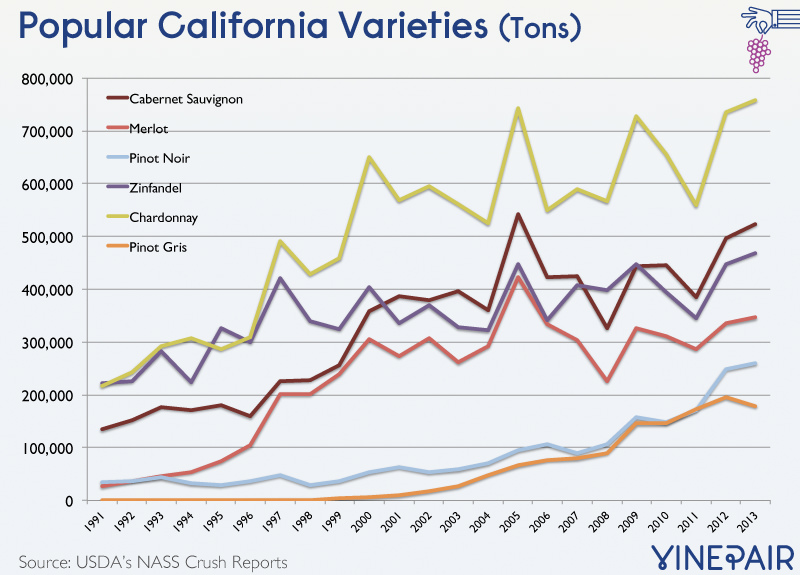Ever since a movie took Merlot down like a luchador in 2004, the wine has gotten a bad rap. With one character line and an Academy Award nomination, the film “Sideways” brought the grape’s reputation to its knees. But was the criticism worth it, and should Merlot’s reputation have suffered the way it did? No. Not really.
Merlot makes wonderful wine. In the low, sloping hills of St. Emilion on the right bank of the Gironde estuary in the Bordeaux appellation, it can produce some of the finest and most expensive wine on the planet. And it is here in the southwestern part of France where Merlot was born.
Like many of the native Bordeaux grape varieties, Merlot is naturally versatile, acclimating to different climate zones and soil compositions, which, over time and a lot of travel, have made it the second most planted red grape on the planet, behind its brother from Bordeaux, Cabernet Sauvignon. The thing is, save for a few chateaux on the right bank, in Bordeaux, the Merlot grape is meant to be blended, usually with Cabernet Sauvignon, in order to create the region’s famous Bordeaux blend. It’s outside of France where we most often see the grape being made into the 100% variety wines we know, and that’s where you find not only great success but also major failures if you take things too far.
As Merlot spread across the world, no other region took things further, and therefore impacted the wine’s reputation more, than California. This is where the problem began. In the 1980s California was becoming a big player in the winemaking world–demand was soaring. With irrigation and winery manipulation, Merlot was the easiest to mass-produce. In 1990s, Merlot grew from less than 30,000 tons of grapes harvested in California to roughly 300,000 tons harvested. Because of its smooth nature, the wine hit an all time high in popularity and it was immediately picked up by the mass market. Merlot hit its high-water mark a year after the movie “Sideways” was released, at a scary 423,711.7 tons, most of which was harvested in the soils of Central California, where the movie takes place. Merlot became “Cabernet Sauvignon without the pain.”
But like any fad, the sudden popularity of Merlot sowed the seeds of its downfall. With demand so high, growers saw that they could increase yields with strong irrigation, which led to a more herbaceous wine, which needed to be manipulated with significant oak exposure to bring it back to the profile that was all the rage. They had taken what was special about Merlot, and made it bland for mass consumption.

So by the early aughts when Rex Pickett was writing a story about loathsome Miles and his best friend Jack and their adventures in Solvang, California, our little blackbird wasn’t doing so well. This may have prompted the line, “…if anyone orders Merlot, I’m leaving. I am NOT drinking any fucking Merlot!”
But the thing is, those failures caused by mass production began as successes. When Merlot first left France to make it in the world, it soared, and it still does in certain regions–you just have to know where to look.
In Northern Italy, the region of Friuli makes some of the most stunning single variety Merlot around. There is actually a tourist route, Strada Del Merlot, that runs along the Isonzo river. In this part of the world, Merlot is supple and smooth, with hints of its natural herbaceous character mingling with soft mocha and blueberry notes. The wines from here can be a bit expensive, but there are also some great entry level examples that shine through.
Here in the States, some of the best Merlot is coming out of Washington. Although the grape can adapt well to many environments, the cool, higher elevation of the Columbia Valley with its poor soils allows this early ripening variety to thrive. These examples are a bit leaner than those from Northeastern Italy and more high toned with brighter fruit notes, but they still retain those awesome peppery notes that make the wine great for all kinds of food.
And being a New Yorker, I would be remiss if I didn’t mention the great success some wineries have had in our own Long Island AVA. It can be a tricky grape on the North and South Fork, but if the grape is taken care of through balanced irrigation and the right vineyard conditions, Merlot can be very enjoyable, giving a lean fruit flavor sweetened with a hint of oak.
Whether it is blended in the chateaux of Bordeaux or taking center stage in the new world of wine, Merlot can satisfy your soul. So before you shove it off, give it a chance. Below are some great examples:
Friuli
Entry Level
Borgo M, Borgo M Merlot
Mid Level
Fiegl, Collio Merlot Leopold
Higher End
La Roncaia, Merlot
Washington State
Entry Level
Independent Producers, Merlot
Mid Level
Revelry, Merlot
Higher End
Seven Hills, Columbia Valley Merlot
New York
Entry Level
Wölffer Estate, Merlot
Mid level
Macari Vineyards, Estate Merlot
Higher End
Shinn Estates, Estate Merlot
California
Entry Level
Castle Rock Winery, Central Coast Merlot
Mid Level
Liberty School, Merlot
Higher End
Hook & Ladder Winery, Hook And Ladder Merlot Russian River
Gundlach Bundschu, Merlot
Header Image via Shutterstock.com
